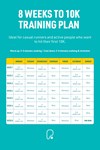Training your way to 10K

Page last updated: 11th April 2023
A 10 kilometre (6.2 miles) race is the perfect challenge for novice runners who want to get more serious, kick their training and fitness up a notch, and prepare for bigger and better challenges down the road.
The 10K blends the best of short recreational runs with longer, more intense ones such as half marathons, offering a manageable challenge (but a challenge nonetheless) which will be fun to work towards.
If you’re a complete beginner, it may be worth checking out our 5K training plan. Once you’re comfortable running that distance then you’ll be ready to step up for the full 10K. We’ve provided tips and advice for your 10K below, or you can jump straight to our 8-week 10K training plan.
Why do you need to train for a 10k?
If you’ve been running recreationally up until now, it’s likely that your training routine may not have been very structured. You may have been going for a short jog each morning, and your natural inclination to train for a 10K might be to simply increase the distance and speed of your runs in preparation for the race.
That’s not necessarily the best way to go about it. If you rush your progress, you could be leaving yourself open to the risk of injury, which could totally impede your training efforts. By training carefully over a series of weeks, you can make sure you’re easing your way up to your 10K run and ensure you can comfortably progress and improve your abilities over time.
Why is a plan important when training for running 10k
By starting out with a firm plan of how you’ll approach your training, you can get a good awareness of how long the process will take, and make sure you’re gently challenging yourself over time. Or alternatively, you can shape your plan to suit your timeframe - if it’s two months until your 10K event you can arrange your training to safely fit within that.
By making a firm plan you’ll also be more likely to stick to your training. It’s easy to let a few sessions slide or stop pushing yourself (or push yourself too far!) if you’re not sticking to a set plan. Having a firm idea of what each week will bring means you can prepare yourself and will be more likely to hit your goals.
How long should a 10k training program cover?
How long it will take you to prepare for a 10K is very dependent on your current fitness level, whether you’re already running and also how much time you have to train each week. For complete starters, you’ll be looking at around 12 weeks to go from couch to 10K. If you’re already running a little each week, then you’ll be more likely to hit the 10k goal in around 8 to 10 weeks.
You’ll ideally need to commit to running or exercising for at least three or four times a week to see steady progress. If your lifestyle means you’re unable to devote that time, you’ll need to adjust your plan accordingly.
What you need to know before training for a 10k
- Always include a warm up before every run: this prepares your muscles for your run session and will reduce your chance of injury
- Never forget to cool down afterwards: this eases your body out of the session and helps to prevent sore and achy muscles post-workout
- Always include rest days, to allow your body to recover: otherwise you could be at risk of overtraining it or burn out. Rest days are important to allow your muscles to repair ready for your next run. You can also use these days to focus on gentle mobility and flexibility with stretching, yoga or pilates
- Train outside (when relevant): If you’re training for an outdoor event, it’s worth training outdoors so you’re prepared for different weathers and environments. Or try playing with the different settings on your treadmill to mimic conditions you’d experience outdoors such as rolling hills or gentle inclines.
- Include a mix of different training styles (see the next section for more)
What to include in your 10k training plan
We recommend including the following to allow you to work on your endurance, speed and technique with little risk of injury or exhaustion.
1. MIX UP THE PACING AND LENGTH OF YOUR RUNS
You should set up a fixed weekly training routine which includes around three runs per week. One of those should be an “easy” run – which should be a slower pace and for a short distance. The next should be a slightly more intense run – increasing your pace but maintaining roughly the same distance as with your easy run. The third should be a “long run” where you should aim to spend a longer time on the road, gradually building up your distance towards your end 10K goal, while still maintaining a calm, manageable pace.
2. ADD UPHILL RUNS TO YOUR TRAINING ROUTE
Uphill runs are fantastic when training for a 10K, as they help to promote proper running posture, while also putting enough strain on the muscles involved to strengthen them and improve your overall speed and power.
Be aware that these hill runs should be done at a reasonable, steady pace, not at a flat-out sprint. You don’t need to utterly exhaust yourself getting to the top – in fact; it’s counterproductive and likely to contribute to injury.
Stay in control when running back downhill as well. Control your pace and prevent yourself from going into the natural full-tilt sprint to the bottom. The better you can control your pace when gravity is telling you to “go!”, the better your form and discipline will become.
Before long you’ll notice that your speed on the flat is improving naturally, and your endurance on hills is getting better too.
3. ADD IN SOME CROSS TRAINING TO KICK THINGS UP A NOTCH
Between your planned weekly runs, you can also include cross-training if you feel like you have the energy to manage it. Good cross training routines are those which work the muscles involved in running, without adding extra stress to your joints.
Having a spin on a stationary exercise bike between training days is also a great way of working your quads and calves without risking injury, while swimming is another fantastic option as it offers the body resistance to work against, without any impact whatsoever.
That doesn’t just include the muscles of the lower body, either – strengthening your upper body too can help to make you more biomechanically efficient overall, and will directly improve your form and ability on the road.
Keep in mind: adding muscle mass while training for a run isn’t a great idea. Any weight you gain is just more weight your body will have to manage when you’re on the road. For this reason, avoid bodybuilding and serious weight training routines and stick to exercises like those mentioned above.
Feel free to throw in some bodyweight calisthenics exercises as well, such as lunges, pushups, pullups, and more. For more exercise moves to try, check out our video below.
the free puregym 8-week 10k training plan
Our 8-week 10K training plan below assumes you can already comfortably run 5K (or near enough). If you’re still working up to this, then check out our 5K training plan first.
You’ll see we’ve included a mix of all of our advice above - so regular rest days (which can also be used to focus on your flexibility and mobility), workout days (ideally a light strength training session or low impact cardio) and a mix of shorter and longer runs.

Download and print the 10K Training Plan
You can learn more about how to improve your running over on our Running hub, where we cover all manner of tips and advice. To help with your fitness, you can download the free PureGym App, which includes a range of workouts to keep you on track.


